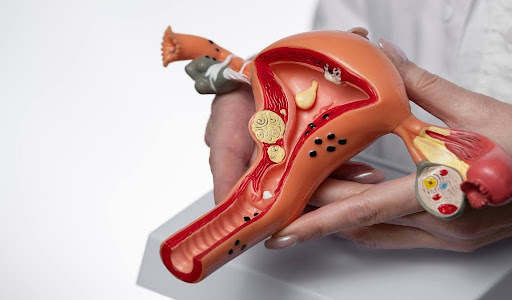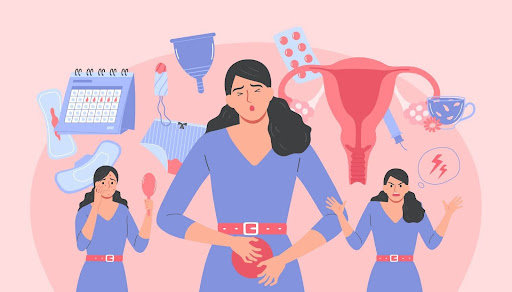Can Telehealth Prescribe Antibiotics for a UTI?
Urinary tract infections (UTIs) are among the most common bacterial infections, especially affecting women. They occur when bacteria enter the urinary system, causing [...]
Read More
Medically reviewed by Abhijit Bhattacharyya | MD, PhD, MBA, Tufts University School of Medicine - Miami, Florida on June 6th, 2025.
Polycystic Ovary Syndrome (PCOS) and endometriosis are two prevalent conditions that affect women's reproductive health. While they share some similarities, they are distinct disorders with different symptoms, causes, and treatment approaches. Understanding these differences is crucial for diagnosis and management. This article delves into the symptoms, diagnosis, and key distinctions between PCOS and endometriosis.
 Understanding PCOS
Understanding PCOSPolycystic Ovary Syndrome is a hormonal disorder that affects approximately 1 in 10 women of reproductive age. It is characterized by a combination of symptoms that can vary widely among individuals. The exact cause of PCOS remains unclear, but it is believed to involve a combination of genetic, hormonal, and environmental factors. This complexity can make it challenging for women to receive a timely diagnosis and appropriate treatment, often leading to a prolonged journey of managing the condition.
Irregular Menstrual Cycles: Women with PCOS often experience irregular or absent menstrual periods.
Excess Androgen Levels: Elevated levels of male hormones can lead to symptoms such as hirsutism (excessive hair growth), acne, and oily skin.
Polycystic Ovaries: Ultrasound may reveal enlarged ovaries with multiple small cysts.
Weight Gain: Many women with PCOS struggle with weight gain or obesity, which can exacerbate other symptoms.
Insulin Resistance: A significant number of women with PCOS may also experience insulin resistance, increasing the risk of type 2 diabetes.
Diagnosing PCOS typically involves a combination of clinical evaluations and tests. Healthcare providers often use the Rotterdam criteria, which require at least two of the following three criteria to be met:
Irregular or absent ovulation
Clinical or biochemical signs of hyperandrogenism
Polycystic ovaries as seen on ultrasound
In addition to these criteria, doctors may conduct blood tests to measure hormone levels and check for insulin resistance. It is also essential for healthcare providers to rule out other conditions that may mimic PCOS, such as thyroid disorders or adrenal gland disorders. This comprehensive approach ensures that women receive an accurate diagnosis and appropriate management tailored to their unique symptoms and health needs.
Furthermore, understanding the emotional and psychological impact of PCOS is crucial. Many women report feelings of anxiety and depression related to their symptoms, particularly concerning body image and fertility issues. Support groups and counseling can be beneficial for those navigating the emotional challenges of living with PCOS. Education about the condition can empower women to advocate for their health, seek appropriate treatments, and connect with others who share similar experiences, fostering a sense of community and support.
Endometriosis is a condition where tissue similar to the lining of the uterus grows outside the uterus, often leading to pain and other complications. It affects an estimated 1 in 10 women during their reproductive years and can significantly impact quality of life. The exact cause of endometriosis remains unclear, but factors such as genetics, immune system disorders, and hormonal influences are believed to play a role. The condition can lead to various complications, including the formation of adhesions and scar tissue, which can further complicate reproductive health and overall well-being.
Painful Periods: One of the hallmark symptoms of endometriosis is dysmenorrhea, or severe menstrual cramps that can be debilitating. Many women describe this pain as more intense than typical menstrual cramps, often radiating to the lower back and thighs.
Pain During Intercourse: Many women with endometriosis report pain during or after sexual intercourse. This discomfort can lead to a decrease in sexual activity and intimacy, impacting relationships.
Chronic Pelvic Pain: This can occur at any time during the menstrual cycle, not just during menstruation. Women may experience persistent pain that can interfere with daily activities and overall quality of life.
Heavy Menstrual Bleeding: Women may experience heavy periods or bleeding between periods, which can lead to anemia and fatigue.
Infertility: Endometriosis is often discovered in women seeking treatment for infertility. It is estimated that 30-40% of women with endometriosis may face challenges in conceiving.
Diagnosing endometriosis can be challenging, as its symptoms often overlap with other conditions. A thorough medical history and pelvic examination are essential first steps. The following methods may be used for diagnosis:
Pelvic Ultrasound: This imaging technique can help identify cysts associated with endometriosis. However, it may not detect all cases, as some endometrial tissue may not form cysts.
Laparoscopy: A surgical procedure that allows direct visualization of endometrial tissue outside the uterus. This minimally invasive surgery is often considered the gold standard for diagnosis, as it provides definitive evidence of the disease.
Biopsy: Tissue samples may be taken during laparoscopy to confirm the presence of endometriosis. The biopsy can help determine the extent of the disease and guide treatment options.
In addition to these diagnostic methods, healthcare providers may also recommend blood tests to check for markers associated with endometriosis, although no definitive blood test currently exists. Women experiencing symptoms are encouraged to maintain a symptom diary, noting the severity and timing of their pain, as this can provide valuable information to healthcare professionals during diagnosis. Early diagnosis and intervention are crucial, as they can help manage symptoms more effectively and improve the overall quality of life for those affected by this complex condition.
While both PCOS and endometriosis can cause reproductive health issues, they differ in several key areas:
Menstrual Irregularities
PCOS: Common
Endometriosis: Possible, but not always
Painful Periods
PCOS: Rare
Endometriosis: Common
Hirsutism
PCOS: Common
Endometriosis: Rare
Infertility
PCOS: Possible
Endometriosis: Common
The underlying causes of PCOS and endometriosis also differ significantly. PCOS is primarily a hormonal imbalance, often linked to insulin resistance and genetic factors.
In contrast, the exact cause of endometriosis remains unclear, but it may involve retrograde menstruation, immune system disorders, and genetic predispositions.
Additionally, lifestyle factors can exacerbate the symptoms of both conditions. For instance, women with PCOS may experience worsening symptoms due to obesity, sedentary lifestyle, and poor dietary choices, which can further complicate insulin resistance. Conversely, women with endometriosis may find that stress and certain environmental factors, such as exposure to endocrine-disrupting chemicals, can intensify their pain and discomfort. Understanding these lifestyle connections is crucial for managing symptoms effectively.
Moreover, the diagnosis and treatment approaches for PCOS and endometriosis also highlight their differences. PCOS is often diagnosed through a combination of clinical evaluations, blood tests to check hormone levels, and ultrasound imaging to assess ovarian morphology.
Treatment typically involves lifestyle modifications, hormonal therapies, and medications to manage symptoms. On the other hand, endometriosis diagnosis may require more invasive procedures, such as laparoscopy, to visualize and potentially remove endometrial tissue. Treatment options for endometriosis can include pain management strategies, hormonal therapies, and in some cases, surgical interventions to alleviate severe symptoms.
Both PCOS and endometriosis require tailored treatment approaches based on individual symptoms and health goals.
Management of PCOS often focuses on lifestyle changes and medications:
Lifestyle Modifications: Weight management through diet and exercise can help regulate menstrual cycles and improve insulin sensitivity.
Hormonal Birth Control: Oral contraceptives can help regulate menstrual cycles and reduce symptoms like acne and hirsutism.
Metformin: This medication is commonly prescribed to improve insulin sensitivity and regulate ovulation.
In addition to these primary treatment options, many women find that incorporating supplements such as inositol can further support metabolic health and ovarian function. Inositol, a carbohydrate that influences insulin signaling, has shown promise in improving ovarian function and may help restore regular ovulation in women with PCOS.
Furthermore, regular monitoring and consultations with healthcare providers can ensure that treatment plans are adjusted as needed, taking into account the evolving nature of symptoms and personal health goals.
Endometriosis treatment may involve a combination of pain management and surgical options:
Pain Relief Medications: Nonsteroidal anti-inflammatory drugs (NSAIDs) can help alleviate pain.
Hormonal Therapy: Hormonal treatments can help reduce or eliminate menstruation, slowing the growth of endometrial tissue.
Surgery: In severe cases, surgical intervention may be necessary to remove endometrial growths and scar tissue.
Moreover, many patients explore complementary therapies such as acupuncture or physical therapy, which can provide additional relief from pain and improve overall well-being.
Acupuncture, in particular, has been noted for its potential to enhance blood flow and reduce inflammation, thereby alleviating some of the discomfort associated with endometriosis.
Additionally, support groups and counseling can be invaluable resources for those coping with the emotional and psychological aspects of living with chronic pain and fertility challenges, fostering a sense of community and shared experience among individuals facing similar struggles.
 Both conditions can have a significant impact on daily life, including emotional well-being and relationships. Support from healthcare providers, family, and support groups can be invaluable.
Both conditions can have a significant impact on daily life, including emotional well-being and relationships. Support from healthcare providers, family, and support groups can be invaluable.
Women with PCOS and endometriosis often experience anxiety and depression due to chronic pain, fertility issues, and the social stigma surrounding these conditions. Mental health support, whether through therapy or support groups, can help individuals cope with these challenges.
The emotional toll can manifest in various ways, such as feelings of isolation, frustration, and helplessness. It's not uncommon for women to feel overwhelmed by the unpredictability of their symptoms, which can interfere with daily activities and long-term plans. Recognizing these feelings and seeking help is crucial for maintaining mental health and overall well-being.
Connecting with others who share similar experiences can provide comfort and practical advice. Online forums and local support groups can be excellent resources for information and emotional support. These networks often create a sense of community, where individuals can share their stories, coping strategies, and even treatment options that have worked for them. Many women find empowerment in discussing their journeys, which can help to break the stigma surrounding these conditions.
Additionally, participating in awareness campaigns or advocacy can foster a sense of purpose, allowing individuals to contribute to a larger movement aimed at educating others and improving healthcare responses to PCOS and endometriosis.
PCOS and endometriosis are two distinct conditions that require careful diagnosis and management. Understanding their differences in symptoms, causes, and treatment options is essential for effective care. Women experiencing symptoms associated with either condition should seek medical advice to ensure appropriate evaluation and treatment. With the right support and management strategies, individuals can lead fulfilling lives despite these challenges.
Struggling to understand the difference between PCOS and Endometriosis? Dive into our detailed comparison of symptoms and diagnosis to take control of your health journey. Doctronic is here to uncover the facts and empower you with knowledge today!
Urinary tract infections (UTIs) are among the most common bacterial infections, especially affecting women. They occur when bacteria enter the urinary system, causing [...]
Read MoreManaging chronic conditions like type 2 diabetes and obesity can be challenging, but advances in medicine and technology are making treatment more accessible than ever. One [...]
Read MoreTelehealth has transformed the way people access healthcare by allowing patients to consult with medical professionals remotely, using digital platforms such as video calls, [...]
Read More